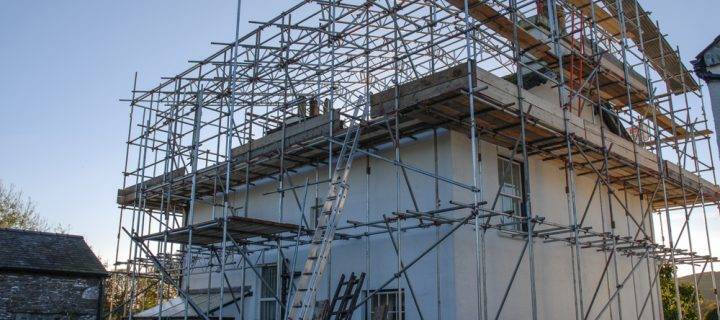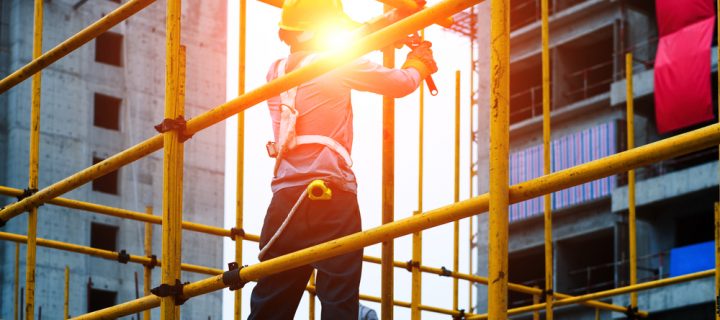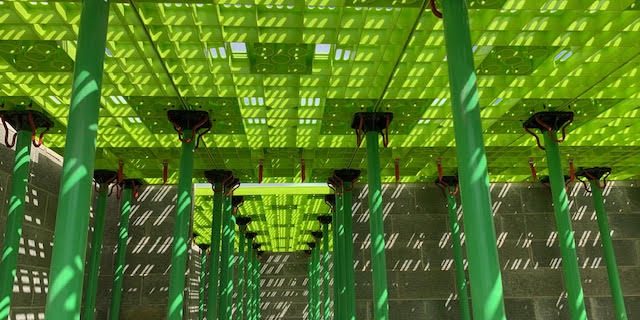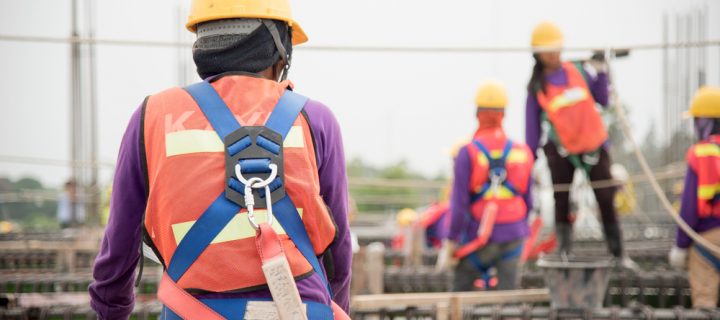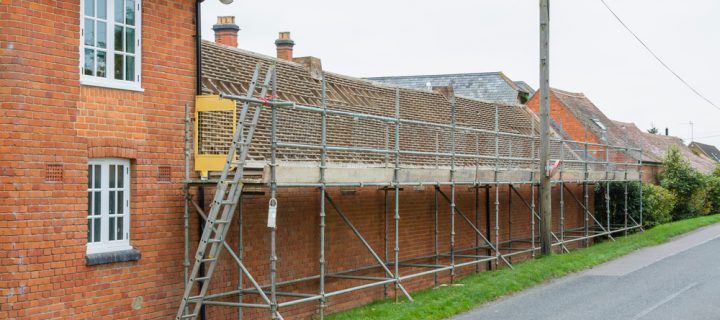Flat roofs, like any other type of roof, do require maintenance to ensure you don’t need to have any repairs completed using scaffolding. Traditionally easier to maintain than a regular roof, flat roofs are asphalt-based and other similar materials. Depending on the quality of the original installation and the continued maintenance, flat roofs can last up to 50 years before they need replacing. Their lifespan is almost as long as tiled roofs, which last for up to 60 years. We would generally recommend checking your roof every spring and autumn, plus after particularly harsh weather, such as storms, strong winds or heavy snowfall. Fixing a flat roof If you discover any splits, blistering or damages, the surface will need properly examining before hiring someone to fix your roof. First, the area will need clearing of any damp or water, but if the surface has split or blistering has occurred it will need repairing. Flat roof repairs for splitting Splitting is quite a common problem for flat roofs, which occurs when the felt or asphalt material covering the roof suffer from cracks or tears. This does not just affect the outer appearance of the roof, plus it also allows water to get in through the gaps and into the interior of your property which results in leaks and damage from damp which can be difficult to fix. Splits in roof material can be caused by a number of things, such as wear and tear from exposure to the elements, stresses on the material, water pooling, freeze-thawing or poor workmanship when it was initially installed. If you have started to notice staining or the beginning signs of dampness on your ceiling or the tops of the walls inside your property underneath a flat roof, this can be a sign of splitting or other damage to the roof that is allowing water to seep in. Ponding on flat roofs Ponding can cause deep concave indents to occur around the roof, with stains and watermarks occurring on the inside of your property. These indents will continue to collect water, damaging material which over time allows water to begin to seep through into your home’s interior. This is usually caused by insufficient drainage, which...
Read Moreabout How to avoid scaffolding for flat roof repairsRecently Network Scaffold Services has expanded its range of products, including plastic hoarding and safety decking for construction projects. Our hoarding is designed for strength, durability, and simplicity which makes it quick and easy to erect, adapt and dismantle. It is also possible to promote your corporate identity on the boards, plus they can be reused for another project in the future. Sustainability benefits Fully reusable and recycle Zero waste to landfill Reduces the carbon footprint of your project 100% recyclable at end of life Commercial and Construction benefits Installation service or training available from our team of installers Quick and easy to erect, adapt and dismantle External and internal applications Where can I use plastic hoarding? Here are some examples of how plastic hoarding can be utilised across different sites – Internal or external shop frontage Ideal for festivals and events needing temporary fencing Hoarding scaffolds and structures Construction and demolition projects Also, suitable for offices, soundproof areas, and hospital sterile areas Why is hoarding so important? Construction sites that use hoarding will keep intruders out plus they will ensure the safety of the general public passing by. The Health and Safety at Work etc Act 1974 and the Construction (Design and Management) Regulations 2015, which were introduced by the HSE’s Construction division state the importance of having secure hoarding around construction sites. Unlike timber construction panels, our plastic panels are water-resistant, which means they do not rot and can be reused; saving you money on standard plywood products. Get in touch for more information If you would like more information about Network Scaffold’s range of plastic hoarding, please do not hesitate to contact us today. Our team of specialists will be more than happy to answer any queries you may have. Don’t forget Network Scaffold also supplies signature scaffolding products such as edge protection, alloy towers plus access scaffold...
Read Moreabout What are the advantages of plastic hoarding?Here at Network Scaffold Services, we work with a number of different types of scaffolding, which are all used for different purposes in construction. For our latest blog, we will talk you through seven different kinds of scaffold available on the market and explain their uses. 7 Different types of scaffolding explained Single – This is commonly known as brick layer’s scaffolding and consists of standards, ledgers, putlogs, which is parallel to the wall at a distance of roughly 1.2m. The distance between the standards is between 2 and 2.5 metres, with ledgers connecting the standards at a vertical interval of 1.2-1.5m. Putlogs are taken out from the hole left in the wall to one end of the ledgers. Putlogs will then be placed at an interval of 1.2-1.5m. Double – Generally used for stone masonry, it is sometimes referred to as mason’s scaffolding. In stone walls, it is difficult to make holes in the wall to support putlogs. Two rows of scaffold will make this strong. Cantilever – This type of system has standards that are supported on a series of needles, that go through holes in the wall. This is known as single frame type scaffolding. For other types, needles are strutted inside the floors through the openings and are known as independent or double frame scaffold. Please note, care needs to be taken when constructing this system. Typically cantilever systems should be used in the following conditions – When the ground doesn’t have the capacity to support standards When the ground near the wall needs to be free from traffic When the upper part of the wall is under construction Suspended – A suspended working platform is based on roofs with the help of wire ropes or chains. This can be raised or lowered to the required level. The system is used for repair works, pointing and paintings. Trestle – For a trestle scaffold platform, it is supported on movable tripods or ladders and is generally used for work inside the room, such as paintings or repairs up to 5 metres in height. Steel – Steel platforms are constructed by steel tubes that are fixed together by steel couplers or fittings. Very easy to construct or...
Read Moreabout What are the different types of scaffolding?Scaffold safety decking has been a widely used component in the construction industry for 20 years. These systems help to prevent falls, with the deck elevated to a position just below the working surface. This original concept has been further developed; with recent systems providing a more rigid and stable working platform using relatively light components, which are easy to erect. Issues that Safety Decking addresses Systems used by Network Scaffold Services are used to combat problems faced by operatives installing roof trusses. These issues include – There is nowhere for them to stand when fixing and bracing trusses Having a satisfactory anchorage point for personal fall arrest equipment is difficult to find The trellis innovation for safety decks protects operatives by providing a temporary work platform. The industry’s standpoint on safety systems has also evolved, with an emphasis on risk control. This includes a heavy lean towards PPE plus the decks being passive collective fall prevention for all operatives working on it. How are these systems manufactured? PVC components for safety decks are manufactured by specialist plastic organisations that use technology for moulding configurations for a number of component shapes. The moulding manufacturing technique provides a number of advantages over other forms of manufacture. As the system components are formed with no requirement for additional cutting of the plastic, which could potentially weaken the component at the cut area. The trellis arrangement is manufactured in aluminium square tubular sections and cut to the required size. Then they are riveted together, forming the extendable trellis. This is the point when the manufacturer’s logo and any further paintwork would be applied. Order your scaffolding systems from Network Scaffold If you are looking for scaffolding systems plus safety decking or even plastic hoarding, Network Scaffold Services is your only destination. We work with domestic and commercial clients across Derby and the surrounding areas; please contact us for more...
Read Moreabout How Safety Decking is constructed?A typical image from a construction site is more than likely to conjure up a half-finished building with several workers navigating around a tall steel structure known as scaffolding. This is one of the most familiar aspects of any architectural job, but why is it so important in construction? We will examine this topic during this blog. Scaffolding is installed at the start of any construction project or maintenance work. It is a temporary platform, offering support and elevation plus it enables workers to carry materials and conduct their work during the construction process. This can include repairs and cleaning but primarily its purpose is to ensure the safety of workers while the building is being maintained or built. An added caveat is that it also provides a level of support to the standing structure. 4 reasons why scaffolding is essential We have put together 4 reasons why the construction industry relies on the scaffold so much – 1. Efficiency – Scaffold provides builders and workers with a safe and secure platform to carry out their duties. The structure allows them to manoeuvre around buildings of any shape and size quickly and more efficiently. Typically they take a single day to be erected, and will essentially reduce the time spent on-site, thus making the overall project more time-efficient. 2. Safety – Working at height carries an element of danger and risk, and as we have previously mentioned a scaffold platform gives workers a safe and secure setting to carry out their tasks whilst being stationed at a considerable height. Safety appliances such as barrier netting and fencing will also ensure the health and safety of the general public below the structure. These barriers will be able to catch any loose debris and create a completely safe and secure working environment for everyone involved. 3. Easy To Access – Scaffold gives builders and workers easy access to parts of buildings that would be difficult to reach otherwise. Using bespoke scaffold structures means it can be constructed in a way to match the building design. 4. Prime Position – One of the main advantages for builders or workers is that scaffold puts them in a strategic position to carry out their...
Read Moreabout Why is scaffolding so important in construction?Safety still remains the main priority for scaffolders, after the NASC 2021 Safety Report reported the second-lowest figure for accidents and injuries throughout 2020. The NASC is one of the leading UK scaffolding trade bodies that publish their annual Safety report and contains accident statistics, analysis and plans to improve safety standards in the scaffold industry. The NASC 2021 Safety Report explained According to their statistics, just 81 incidents were reported last year; which is just 7 more than the previous year (2019), which was an all-time low. The NASC has stated that the 99.5% of its members went through the entire year accident and injury-free. Some other interesting anecdotes from the report include, the main causes of slips and trips were human error (55%), followed by poor site housekeeping and poor ground conditions (both 19%), and 69% of all recorded operative falls from height were suffered by scaffolders in the 31-40 age bracket. Lynn Way, NASC President commented, “Whilst we’re proud of the headlines figures contained within this year’s Safety Report, this publication is intended to be much more than just a line in the sand, an annual yardstick to measure general safety success against previous years. “It is also a way in which we can learn why incidents occurred with a view to developing ways in which to reduce them – benefiting both NASC members and the wider scaffolding and construction industries.” Robin James, NASC Managing Director added, “It should be remembered that during 2020 scaffolders were faced with challenging Covid-19 related working conditions, with operatives forced to significantly change the way they worked on-site. Also, they ensured that safety standards were not compromised.” The Safest Scaffolding in Derby Network Scaffold Services are the leading provider of scaffolding, for clients right across Derby and the surrounding areas. We have also recently expanded our services to include safety decking and plastic hoarding. If you would like a free no-obligation for any of our products, please do not hesitate to contact us...
Read Moreabout Safety still the main priority for scaffolders
